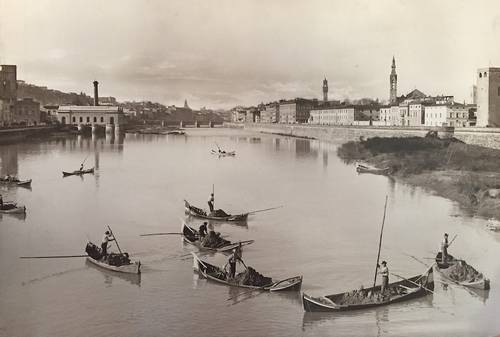
Almost the first house you come to on the peaceful Lungarno Soderini (which skirts the Arno as it flows downstream away from the centre of Florence) is the Museo Bellini, in a charming small building designed at the turn of the last century by the eccentric architect Gino Coppedè for Luigi Bellini, the most famous collector and antiquarian in a family still dedicated to this activity (and who still live here). A wisteria in the garden climbs all the way along the front across the little balcony. It was built specifically to house the Bellini collection, put together by generations of the family since the mid-18th century (and is connected to their residence by a spiral stair). The interior is filled with many precious works of art: paintings and sculptures; genuine, unrestored 15th- and 16th-century furniture; majolica and works by the Della Robbia, and small bronzes. The present Luigi Bellini tells of travels in Italy with his father when just a young child: while waiting outside a house while a transaction was underway he would open his bag and play with the small bronzes he found there.
The property is much larger than it appears from the river front: it stretches all the way back to Borgo San Frediano, and the rooms get older as the property recedes. The oldest part, Palazzo Soderini, dates from the 15th century or even earlier.
The atmosphere is unforgettable and it seems almost superfluous to name some of the treasures, or to be too fussy over the attributions (perhaps sometimes over-ambitious) and dates. But to give an idea of the diversity, there are paintings by Bronzino, Suttermans, Luca Carnevalis (a view of Venice), Guidoriccio Cozzarelli (two gold-ground panels with saints), and even a little private altar of the Madonna with the standing Child attributed to Fra’ Angelico (the doors of the tabernacle are opened for you). But it is perhaps the Cupid and Psyche, thought to be by Rubens, which is the most striking painting of all. The painted wood sculpture includes two beautiful pieces by Francesco da Valdambrino, and there is a splendid collection of small Renaissance bronzes (some of them charmingly displayed in a 16th-century sacristy cupboard). There is also a painted papier-mâché bust of a female saint showing affinities with Donatello and a female bust in wood (which still has its real lace bonnet intact) probably by Neroccio di Bartolomeo Landi (this, together with other pieces, was purchased in an early 20th-century sale at Palazzo Davanzati). A very fine polychrome stucco bas-relief of the Deposition is given to the hand of Bandinelli. The majolica comes from the best known manufactories in Italy and there is very rare early Hispano-Moresque lustreware.
The rooms are dimly lit, some of the walls lined with velvet, others with lovely tapestries, and there are worn carpets underfoot. The atmosphere is that of a treasure-trove of other days when collecting was an art performed by connoisseurs who, one feels, surely purchased objects for their intrinsic beauty rather than their monetary value.
NB: Visits to the museum are by previous appointment. T: 055 214031
or contact through www.bellinmuseum.org.
After the visit it is worth continuing along the Lungarno as far as the piazza in front of the church of San Frediano in Cestello (open 9.30–11.30 & 5-6.30): after rain the sound of the waters of the Arno as they flow over a dyke in the river are reflected off the bare façade. The interior is interesting for its late 17th- and early 18th-century painted decorations and a lovely polychrome wood statue of the Madonna (all described in Blue Guide Florence). From here there is a charming view of the humble houses and terraces of the district of San Frediano in the Oltrarno.
by Alta Macadam. Alta is the author of many Blue Guides to Italy. She is currently working on a new edition of Blue Guide Rome.






